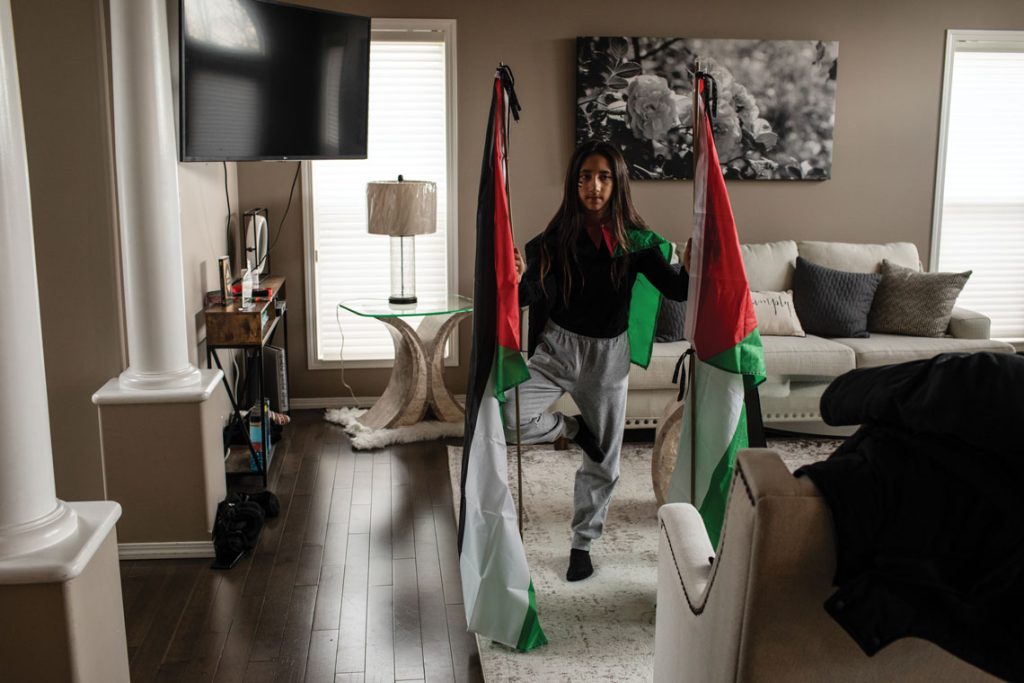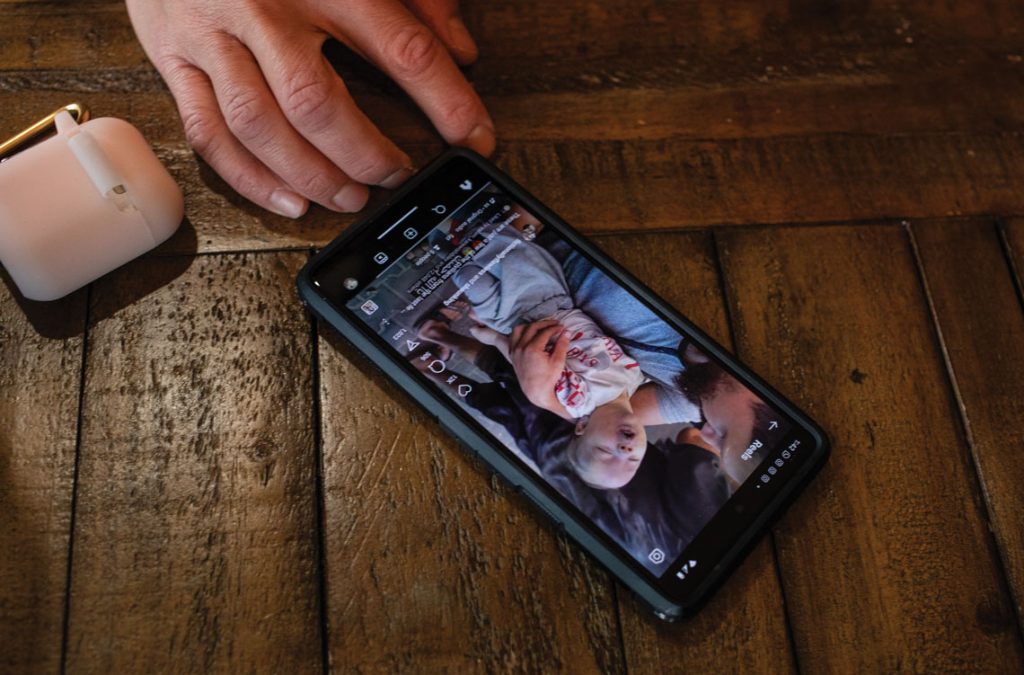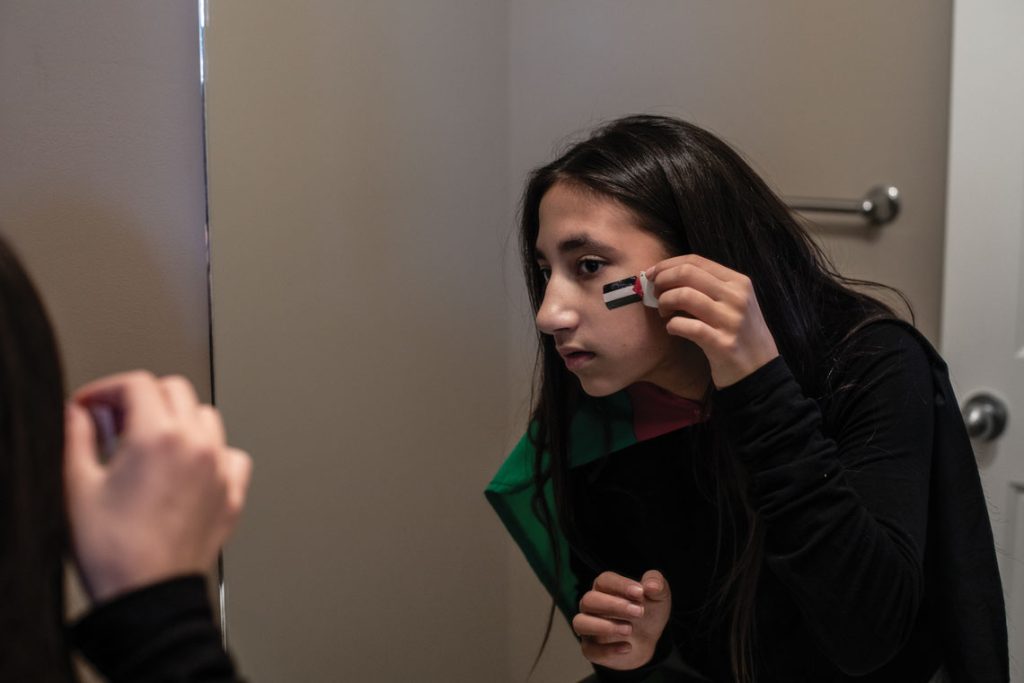I wish children didn’t die.
I wish they would be temporarily
elevated to the skies until the war ends.
Then they would return home safe,
and when their parents would ask them:
“Where were you?” they would say:
“We were playing in the clouds.”
—Ghassan Kanafani
Frost was settling on saskatoon bushes in the yard, contrasting white on the siding against the black puck marks on the driveway. Inside, a fruiting fig tree sat in a darkened window. But in the basement of her Edmonton home, 10-year-old Zeher Assaf was running. Her feet went pat-pat, pat-pat, pat-pat, marking a steady rhythm against the droning treadmill belt.
It was hours past bedtime. Her mom said she could run another day, it was not her fault her relatives left so late. But at nearly midnight on November 8—a school night—Zeher would not be deterred. “I didn’t want to mess up,” she says.
Zeher had committed to run the length of the Gaza Strip, 40 kilometres, as a fundraiser. Throughout the horrors of this conflict, streamed live over social media, many adults have shouted, while others have stayed silent or hopeless in their refrains of “it’s complicated.” But for Zeher it was simple—she would help.
A month before, she wasn’t thinking about Palestine. She knew there was conflict, but like any pre-teen she was preoccupied with other things in life—friends, school, track. She was busy playing with her cousins or watching her favourite cartoon, SpongeBob SquarePants, or trekking to her brothers’ hockey games.
Now she was halfway through eight consecutive days of five-kilometre runs, each day five times her normal max.
Zeher was getting tired.
Sometimes she would entertain herself by thinking of a song she likes, such as Taylor Swift’s “Shake It Off.” Kilometre after kilometre, adding a melody in her mind to the rhythm of her feet, the tempo of her heartbeat, the hum of the machine:
“But I keep cruisin’
Can’t stop, won’t stop movin’
It’s like I got this music
In my mind sayin’, ‘It’s gonna be alright’ ”
But now she kept thinking about the kids like her, a world away, hurt and dying.
“Mom, what’s wrong? Why are you crying?” Children are being hurt.
It was Sunday, October 7, the day after Hamas had shocked the world with the bloody attack on Israeli civilians. Zeher, still oblivious, pulled on a black dress, straightened her long dark hair, patted on a touch of pink lip gloss, and, after packing it into a quilted gold clutch with her cell phone, she was ready—off to join 500 guests at her Lebanese family’s wedding.
Like many of the older guests, Zeher’s grandfather had lived through wars in Lebanon. Even after raising his family in Fort McMurray he was still attentive to the on-again, off-again regional fighting, worrying about what might come next.
Of course, he couldn’t have known then that months of intense Israeli retaliation would kill more than 30,000 Gazans. While world leaders have authorized aid, or bombings, or brokered hostage releases, or revoked UNRWA funding, or brought charges of genocide to the international court, parents everywhere have tried their best to shield their children.
As of February this year, more than 13,000 Palestinian kids have been killed. An average of 10 a day have suffered amputations, many without anaesthetic. Many more have lost homes, family members and schools. At least 33 Israeli children were killed in October.
At the wedding, still protected from such dark knowledge, Zeher danced happily with her great-grandmother. But in the days to come, she started to notice the change. Now her mom was always on her phone. Sometimes while she made dinner. Sometimes with tears running down her cheeks.
“Mom, what’s wrong? Why are you crying?” Zeher asked. Her mom said children were hurt and it was making her sad. She said Palestinians didn’t have freedom, and it’s a long story. Her mom started to mirror her phone on the TV sometimes, letting Instagram stories play so she could watch from the kitchen.
One day Zeher walked in and there, on her living room television: a dusty toddler leaned against a tiled wall as tremors shook his tiny frame. His eyes were wide, wide open, even his pupils spread like dark moons as he looked everywhere and nowhere. “I was asleep,” he says in Arabic. When a doctor folded the child into an embrace, only then did the boy cry.
Zeher started to cry too.
“Why is this happening?” she asked. But answers were exploding farther and farther from comprehension.
After recess, streams of kids flowed through school hallways to a locked classroom, and in the little eddy of waiting students, Zeher joined an argument.
“He was like, oh, ‘Palestine started it first, so they deserve it.’ And then I told him, “No, they didn’t. Israel started bombing them and stuff in 1948.’ And he didn’t believe me.”
Of course, there’s more to the story than either of the kids could have known. Jews, Muslims and Christians all have thousands of years of history there. And the modern conflict is influenced by, among other things, foreign interference, a series of wars, mass displacement, the Holocaust, failed peace agreements, Jewish settlements and, since 1967, militarized occupation of Palestinian territory.
For Zeher, all that mattered was that Israel was bombing Gaza and kids were getting hurt—she wanted people to care. So for her next track practice, she pinned a Palestinian flag around her shoulders.
“Mom, what if they don’t like it?”
But on the field, her coach told her it was beautiful, waving as she ran—even if it caught around her legs. Zeher switched to a smaller flag and wore it as often as she could. To school, track, ceasefire protests and errands—she was conspicuous at an NHL event. She wore it to the rink to cheer for her brothers, pinned at the neck with a tiny Canadian flag.
She was excited to wear it to a local fun run, until it was cancelled. But an hour later her mom’s inbox chimed with a serendipitous invite from Islamic Relief Canada, a faith-based humanitarian charity, to “Run for Gaza.”
Zeher only had to raise $250 to qualify—easy—so they set a stretch goal of $1,000 and signed up. Her mom, a medalled runner, could help. And, of course, Zeher would wear the Palestinian flag.
On Halloween her flag trailed her as she roamed the playground with her costumed friends—Hermione Granger, a dumpster, a pink princess and Ghostface. Later, trick-or-treating with her little brother, the pair were a streak of red, white, green and black among the nighttime ghouls and heroes. All of the houses were kind—each kid went home with a bag full of candy, even some full-sized chocolate bars.
Zeher’s parents had screened her from the worst social media images. Still, she had seen enough—she saw whole neighbourhoods in rubble, an ice cream truck, the most joyful of trucks, now repurposed to cool corpses. But the day the fundraising page went live, one picture collapsed the space between Zeher and Gaza.
Children’s shoes rested white on a blue medical sheet. They were just like a pair she had, tucked safely in her closet. But these shoes were drenched in blood. Their tongues were crimson, every crevice and lace was stained, nearly obscuring the pink Nike swooshes.
She was walking in a parallel reality.
“They’re no different from us. They’re all humans like us,” she says. “They deserve justice and love and rights.”
They upped the goal to $10,000. She rolled change at the kitchen table—$150. Her brother sold his Halloween candy and chocolate almonds—$100. Her family sent money, and within days the online donations reached $5,500.
Zeher ran her first-ever five kilometres—red, sweaty and breathing hard—for Gaza. She felt the effort the next day, but she had to do it again.
On Facebook, Abdelrahman, 7, and Omar, 5, lay still in white shrouds. Their father, doctor Iyad Shaqura, bowed to embrace their bodies.
The following afternoon, Zeher ran five more kilometres.
On Facebook a sobbing boy asked, “Why are you killing them? Small kids in hospitals, why are you like this? Why don’t you go help them? Help them, please.”
The next day, Zeher couldn’t run until nearly midnight. She was only halfway to her goal. In the morning, she was so stiff it hurt to walk. But after some stretching, she ran at the indoor track while her aunt and a cousin cheered another milestone—$8,000.
On Facebook, in the Nur Shams refugee camp, young Ahmed wrote: “You can’t make us leave our home.”
The next day, her legs carried her five more kilometres.
On Instagram, 13-year-old double-amputee Layan al-Baz: “I don’t want false legs. False legs will remind me, and I don’t want to remember.”
They doubled the goal to $20,000. Zeher ran again.
Across the finish line, “Yeah, Zuzu! So proud of you, we love you!”
So often Zeher’s family orbited around hockey, but today her big brother and her dad, a volunteer coach, left the tournament early to cheer for her grand finale. Now they were in the growing crowd of supporters—Zeher was the star. She frolicked through the crowd, cooing at the babies, alternately teasing or high-fiving cousins and accepting affections of proud older relatives.
“GO ZUZU GO”—her cousin’s handmade sign invoked her nickname. Palestinian flags waved gently overhead in the setting sun, keffiyehs rested on shoulders below.
The air started to bite at fingertips but Zeher was warm, bouncing and fidgeting with the tension of the starting line.
“Oh my god, the time’s coming, the time’s coming,” Zeher bubbled over. “I’m literally shaking right now. I’m so scared.”
“THREE, TWO, ONE, GO! GO ZUZUUU!” And her feet tap-tap, tap-tapped the asphalt.
Her mom led the way. A family friend and trainer paced with Zeher, coaching as they ran. By the first kilometre, the sharp edge of a cramp shot through her muscles. At kilometre three, her cousins joined, running along in support. She smacked her gum and gulped air. In the last kilometre, she wondered if her legs would break. The trainer asked if they were almost done.
“I don’t knoooowwww,” she said, her exaggerated whine proving she was OK.
Then there were the final stairs, climbing up and up, and she was across the finish line tape, in the envelope of cheers and bells and horns. “Yeah, Zuzu! So proud of you, we love you! Great job, Zuzu!” She was awash in glitter cannons, flowers and so many cheek-smacking kisses.
Everyone cheered the $16,000 total—her parents later added another $4,000 to maximize the federal government’s donation matching commitment. While all the adults congratulated her, her little brother spelled out his best reward.
“You’re getting to eat chips! Everything on the table tonight,” he declared. “Eve-ry-thing you want!”
Back at hockey, one of the parents told her he was proud of her—the man’s cousin and cousin’s son had been killed in Gaza. After the run, money still trickled in. Zeher returned her family’s bottles and donated some of her own gift money. Her aunt baked cookies for $30 a dozen and raised another $784. The fundraiser finally closed at $25,050—Islamic Relief would later recognize her with an award.
Zeher’s next fundraiser might be a hot-chocolate stand, or maybe another, even longer run.
The next week at school, Zeher sat in her homeroom class while her teacher screened the CTV segment on her fundraiser.
“It was pretty cool to see all the kids seeing what I did and them being shocked,” says Zeher. They watched together as she ran across the finish line then stood steady in the bright camera light.
“Um, I thought it was pretty sad to see lots of children and babies dying. And so that’s what motivated me,” she told the reporter.
Zeher still did not understand why people were being killed, but for her, the action was obvious.
“You should help.”
Amber Bracken is a photojournalist arrested in 2021 while reporting pipeline protests. In 2022 she won the overall World Press Photo of the Year for “Kamloops Residential School.”
____________________________________________







